Effect of Nanodisks at Different Positions on the Fano Resonance of Graphene Heptamers
Abstract
:1. Introduction
2. Simulated Methods and Models
3. Simulation Results and Discussions
3.1. The Effect of the Chemical Potential of the Central Nanodisk on Fano Resonance
3.2. The Effect of a Single Nanodisk in the Ring on Collective Behavior
3.3. The Effect of the Top and Bottom Nanodisks in the Ring on Collective Behaviors
4. Conclusions
Author Contributions
Funding
Conflicts of Interest
References
- Barnes, W.L.; Dereux, A.; Ebbesen, T.W. Surface plasmon subwavelength optics. Nature 2003, 424, 824. [Google Scholar] [CrossRef] [PubMed]
- Kelly, K.L.; Coronado, E.; Zhao, L.L.; Schatz, G.C. The optical properties of metal nanoparticles: The influence of size, shape, and dielectric environment. ACS Publ. 2003, 34, 668–677. [Google Scholar]
- Low, T.; Avouris, P. Graphene plasmonics for terahertz to mid-infrared applications. ACS Nano 2014, 8, 1086–1101. [Google Scholar] [CrossRef] [PubMed]
- Pitarke, J.; Silkin, V.; Chulkov, E.; Echenique, P. Theory of surface plasmons and surface-plasmon polaritons. Rep. Prog. Phys. 2006, 70, 1. [Google Scholar] [CrossRef]
- Zohar, N.; Chuntonov, L.; Haran, G. The simplest plasmonic molecules: Metal nanoparticle dimers and trimers. J. Photochem. Photobiol. C Photochem. Rev. 2014, 21, 26–39. [Google Scholar] [CrossRef]
- Liu, N.; Langguth, L.; Weiss, T.; Kästel, J.; Fleischhauer, M.; Pfau, T.; Giessen, H. Plasmonic analogue of electromagnetically induced transparency at the drude damping limit. Nat. Mater. 2009, 8, 758. [Google Scholar] [CrossRef]
- Fleischhauer, M.; Imamoglu, A.; Marangos, J.P. Electromagnetically induced transparency: Optics in coherent media. Rev. Mod. Phys. 2005, 77, 633. [Google Scholar] [CrossRef]
- Pitchappa, P.; Manjappa, M.; Ho, C.P.; Singh, R.; Singh, N.; Lee, C. Active control of electromagnetically induced transparency analog in terahertz mems metamaterial. Adv. Opt. Mater. 2016, 4, 541–547. [Google Scholar] [CrossRef]
- Rahmani, M.; Lei, D.Y.; Giannini, V.; Lukiyanchuk, B.; Ranjbar, M.; Liew, T.Y.F.; Hong, M.; Maier, S.A. Subgroup decomposition of plasmonic resonances in hybrid oligomers: Modeling the resonance lineshape. Nano Lett. 2012, 12, 2101–2106. [Google Scholar] [CrossRef]
- Fedotov, V.; Papasimakis, N.; Plum, E.; Bitzer, A.; Walther, M.; Kuo, P.; Tsai, D.; Zheludev, N. Spectral collapse in ensembles of metamolecules. Phys. Rev. Lett. 2010, 104, 223901. [Google Scholar] [CrossRef]
- Luk’yanchuk, B.; Zheludev, N.I.; Maier, S.A.; Halas, N.J.; Nordlander, P.; Giessen, H.; Chong, C.T. The fano resonance in plasmonic nanostructures and metamaterials. Nat. Mater. 2010, 9, 707. [Google Scholar] [CrossRef] [PubMed]
- Hentschel, M.; Saliba, M.; Vogelgesang, R.; Giessen, H.; Alivisatos, A.P.; Liu, N. Transition from isolated to collective modes in plasmonic oligomers. Nano Lett. 2010, 10, 2721–2726. [Google Scholar] [CrossRef] [PubMed]
- Meng-Jun, L.; Hui, F.; Xiao-Ming, L.; Xiao-Cong, Y. Subgroup decomposition analyses of d-3h and d-4h plasmonic metamolecule fano resonance spectrum. Acta Phys. Sin. 2016, 65, 057302. [Google Scholar]
- Dayal, G.; Chin, X.Y.; Soci, C.; Singh, R. High-q whispering-gallery-mode-based plasmonic fano resonances in coupled metallic metasurfaces at near infrared frequencies. Adv. Opt. Mater. 2016, 4, 1295–1301. [Google Scholar] [CrossRef]
- Giannini, V.; Francescato, Y.; Amrania, H.; Phillips, C.C.; Maier, S.A. Fano resonances in nanoscale plasmonic systems: A parameter-free modeling approach. Nano Lett. 2011, 11, 2835–2840. [Google Scholar] [CrossRef] [PubMed]
- Fan, J.A.; Bao, K.; Wu, C.; Bao, J.; Bardhan, R.; Halas, N.J.; Manoharan, V.N.; Shvets, G.; Nordlander, P.; Capasso, F. Fano-like interference in self-assembled plasmonic quadrumer clusters. Nano Lett. 2010, 10, 4680–4685. [Google Scholar] [CrossRef] [PubMed]
- Le Perchec, J.; Desieres, Y.; Espiau de Lamaestre, R. Plasmon-based photosensors comprising a very thin semiconducting region. Appl. Phys. Lett. 2009, 94, 181104. [Google Scholar] [CrossRef]
- Song, S.; Chen, Q.; Jin, L.; Sun, F. Great light absorption enhancement in a graphene photodetector integrated with a metamaterial perfect absorber. Nanoscale 2013, 5, 9615–9619. [Google Scholar] [CrossRef]
- Cai, Y.; Zhu, J.; Liu, Q.H. Tunable enhanced optical absorption of graphene using plasmonic perfect absorbers. Appl. Phys. Lett. 2015, 106, 043105. [Google Scholar] [CrossRef] [Green Version]
- Mirin, N.A.; Bao, K.; Nordlander, P. Fano resonances in plasmonic nanoparticle aggregates. J. Phys. Chem. A 2009, 113, 4028–4034. [Google Scholar] [CrossRef]
- Brown, L.V.; Sobhani, H.; Lassiter, J.B.; Nordlander, P.; Halas, N.J. Heterodimers: Plasmonic properties of mismatched nanoparticle pairs. ACS Nano 2010, 4, 819–832. [Google Scholar] [CrossRef] [PubMed]
- Qiu, R.; Lin, H.; Huang, J.; Liang, C.; Yi, Z. Tunable multipolar fano resonances and electric field enhancements in au ring-disk plasmonic nanostructures. Materials 2018, 11, 1576. [Google Scholar] [CrossRef] [PubMed]
- Khardikov, V.V.; Iarko, E.O.; Prosvirnin, S.L. Trapping of light by metal arrays. J. Opt. 2010, 12, 045102. [Google Scholar] [CrossRef]
- Yi, Z.; Niu, G.; Ye, X.; Luo, J.; Li, X.; Jiang, X.; Huang, J.; Yi, Y.; Duan, T.; Zhang, J. Nanodisk-induced modification of plasmon coupling and appearance of fano resonance without symmetry breaking in concentric ag nanoring-nanodisk. Plasmonics 2017, 12, 889–898. [Google Scholar] [CrossRef]
- Heeg, S.; Fernandez-Garcia, R.; Oikonomou, A.; Schedin, F.; Narula, R.; Maier, S.A.; Vijayaraghavan, A.; Reich, S. Polarized plasmonic enhancement by au nanostructures probed through raman scattering of suspended graphene. Nano Lett. 2012, 13, 301–308. [Google Scholar] [CrossRef]
- Ren, J.; Qiu, W.; Chen, H.; Qiu, P.; Lin, Z.; Wang, J.-X.; Kan, Q.; Pan, J.-Q. Electromagnetic field coupling characteristics in graphene plasmonic oligomers: From isolated to collective modes. Phys. Chem. Chem. Phys. 2017, 19, 14671–14679. [Google Scholar] [CrossRef]
- Ren, J.; Wang, W.; Qiu, W.; Qiu, P.; Wang, Z.; Lin, Z.; Wang, J.-X.; Kan, Q.; Pan, J.-Q. Dynamic tailoring of electromagnetic behaviors of graphene plasmonic oligomers by local chemical potential. Phys. Chem. Chem. Phys. 2018, 20, 16695–16703. [Google Scholar] [CrossRef]
- Ren, J.; Wang, G.; Qiu, W.; Chen, H.; Qiu, P.; Kan, Q.; Pan, J.-Q. A flexible control on electromagnetic behaviors of graphene oligomer by tuning chemical potential. Nanoscale Res. Lett. 2018, 13, 349. [Google Scholar] [CrossRef]
- Guo, X.; Hu, H.; Zhu, X.; Yang, X.; Dai, Q. Higher order fano graphene metamaterials for nanoscale optical sensing. Nanoscale 2017, 9, 14998–15004. [Google Scholar] [CrossRef]
- Hu, H.; Yang, X.; Zhai, F.; Hu, D.; Liu, R.; Liu, K.; Sun, Z.; Dai, Q. Far-field nanoscale infrared spectroscopy of vibrational fingerprints of molecules with graphene plasmons. Nat. Commun. 2016, 7, 12334. [Google Scholar] [CrossRef]
- Shi, B.; Cai, W.; Zhang, X.; Xiang, Y.; Zhan, Y.; Geng, J.; Ren, M.; Xu, J. Tunable band-stop filters for graphene plasmons based on periodically modulated graphene. Sci. Rep. 2016, 6, 26796. [Google Scholar] [CrossRef] [PubMed]
- Han, X.; Wang, T.; Li, X.; Xiao, S.; Zhu, Y. Dynamically tunable plasmon induced transparency in a graphene-based nanoribbon waveguide coupled with graphene rectangular resonators structure on sapphire substrate. Opt. Express 2015, 23, 31945–31955. [Google Scholar] [CrossRef] [PubMed]
- Fu, Y.H.; Zhang, J.B.; Yu, Y.F.; Luk’Yanchuk, B. Generating and manipulating higher order fano resonances in dual-disk ring plasmonic nanostructures. ACS Nano 2012, 6, 5130. [Google Scholar] [CrossRef]
- Fang, Z.; Cai, J.; Yan, Z.; Nordlander, P.; Halas, N.J.; Zhu, X. Removing a wedge from a metallic nanodisk reveals a fano resonance. Nano Lett. 2011, 11, 4475–4479. [Google Scholar] [CrossRef]
- Mario, H.; Daniel, D.; Ralf, V.; Harald, G.; Na, L. Plasmonic oligomers: The role of individual particles in collective behavior. ACS Nano 2011, 5, 2042. [Google Scholar]
- Zhang, W.; Gallinet, B.; Martin, O.J.F. Symmetry and selection rules for localized surface plasmon resonances in nanostructures. Phys. Rev. B Condens. Matter 2010, 81, 5032. [Google Scholar] [CrossRef]
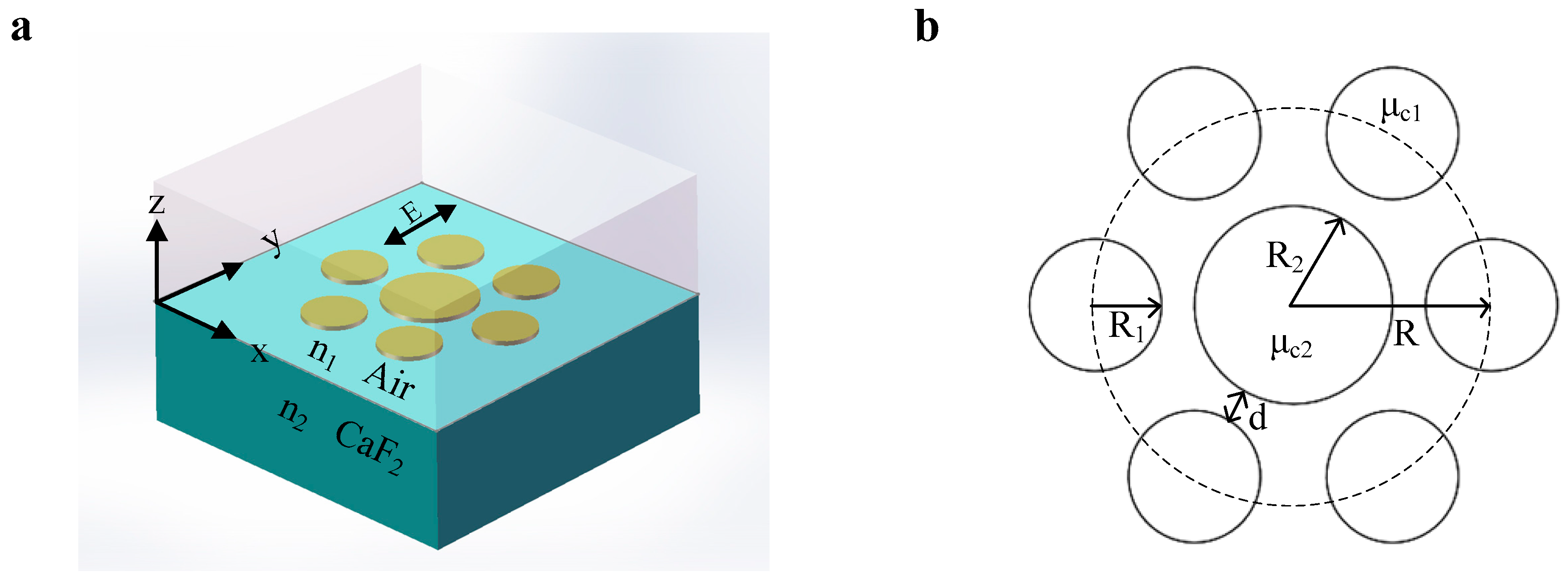

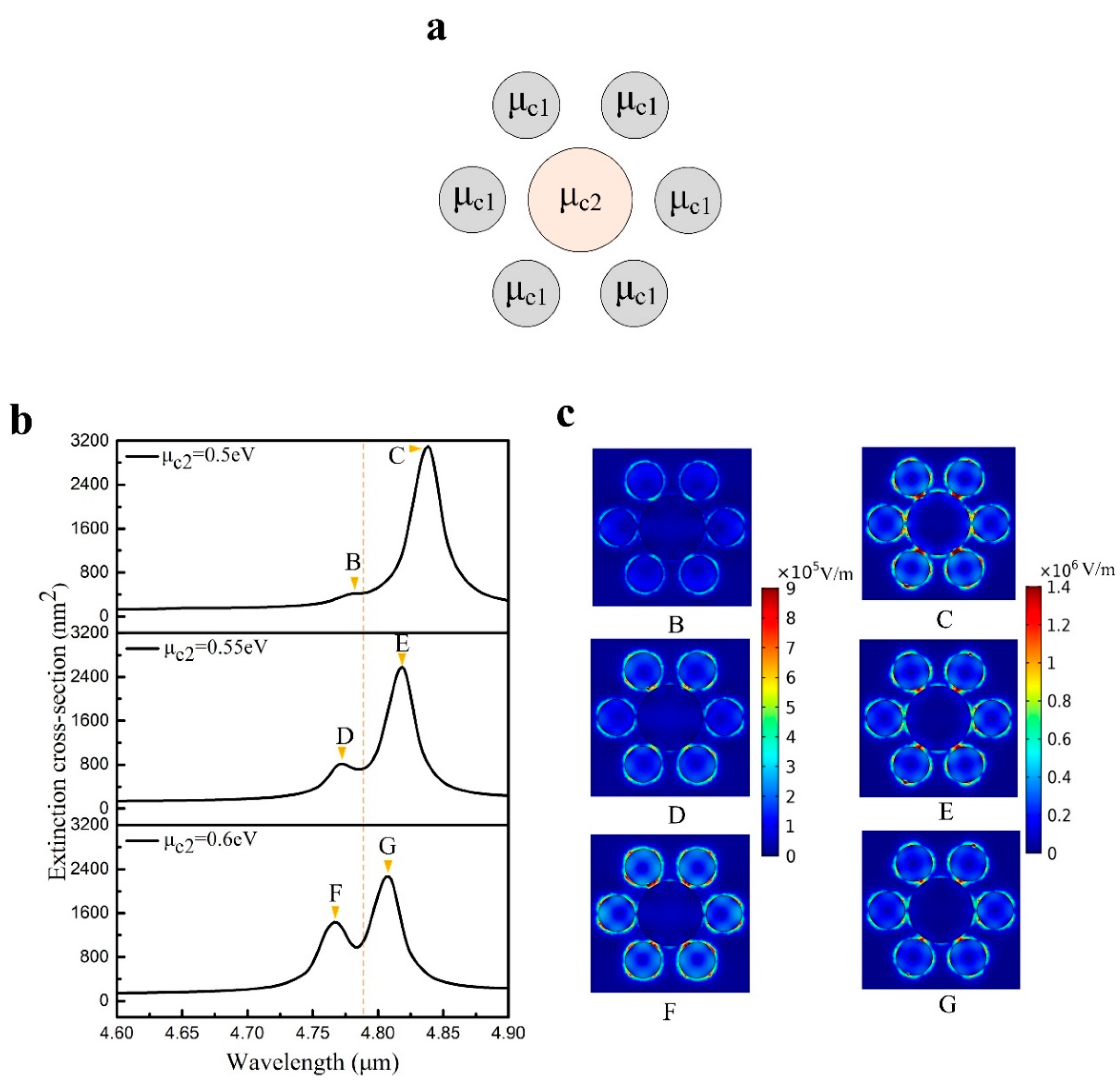
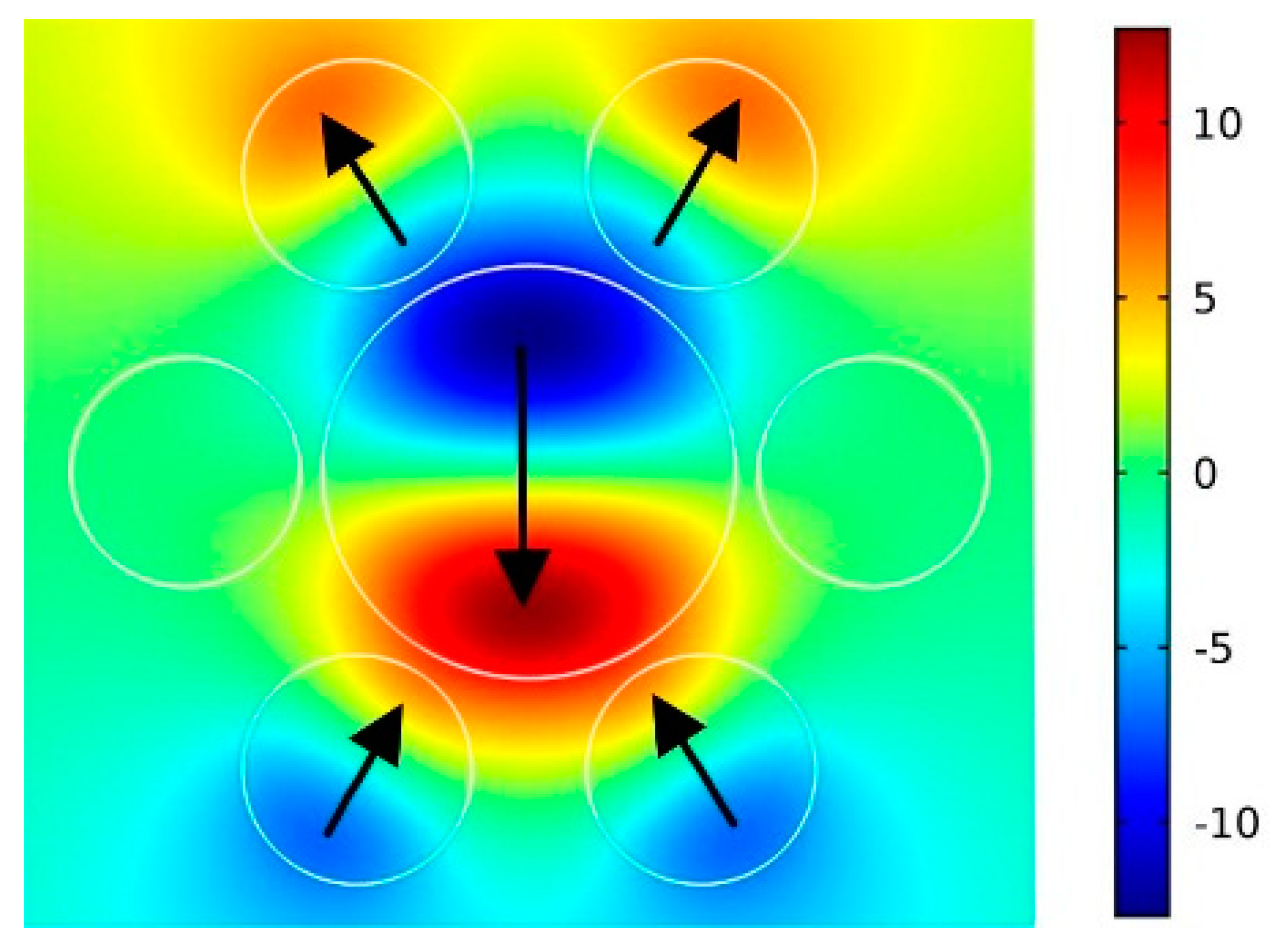
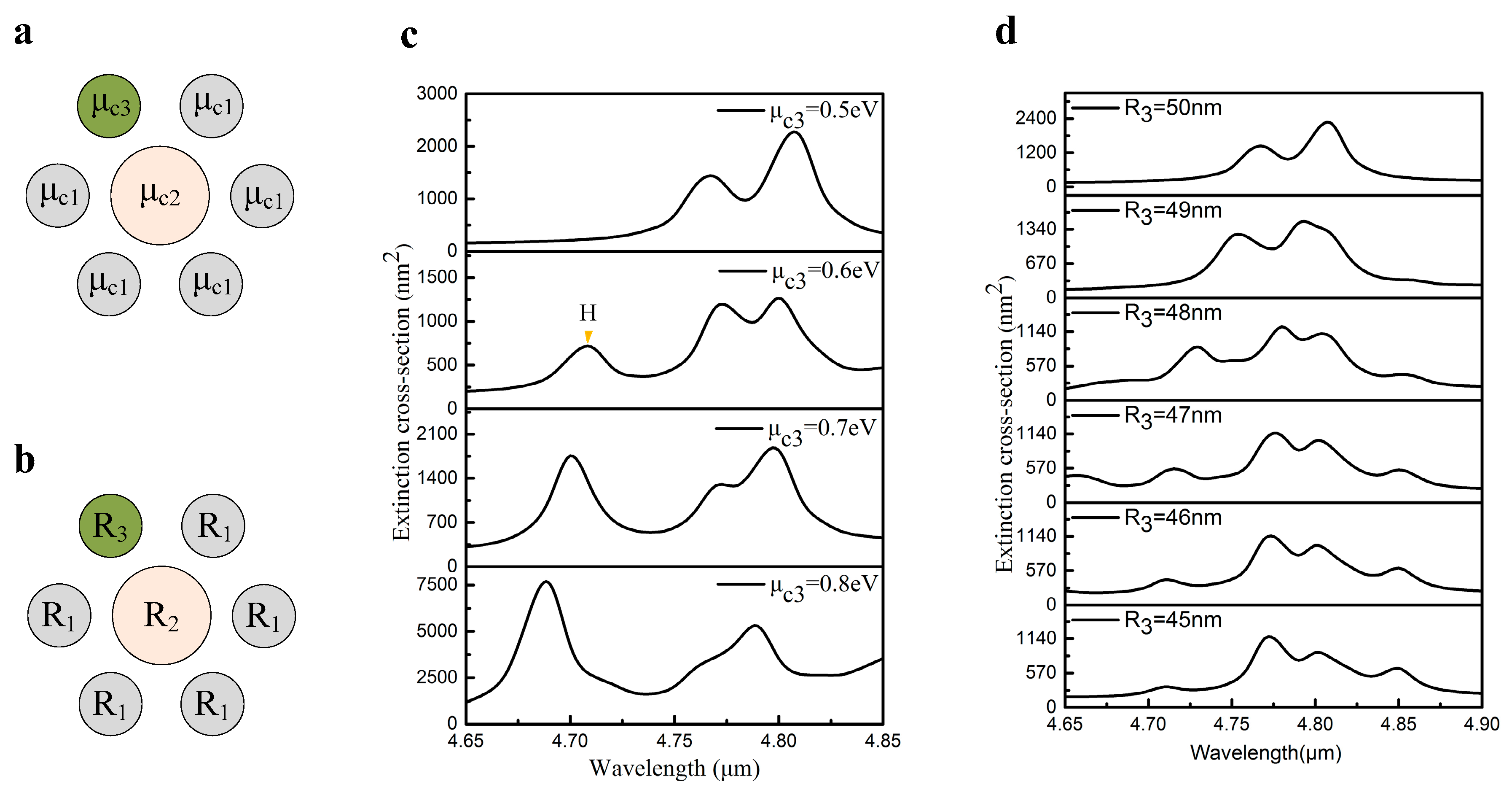
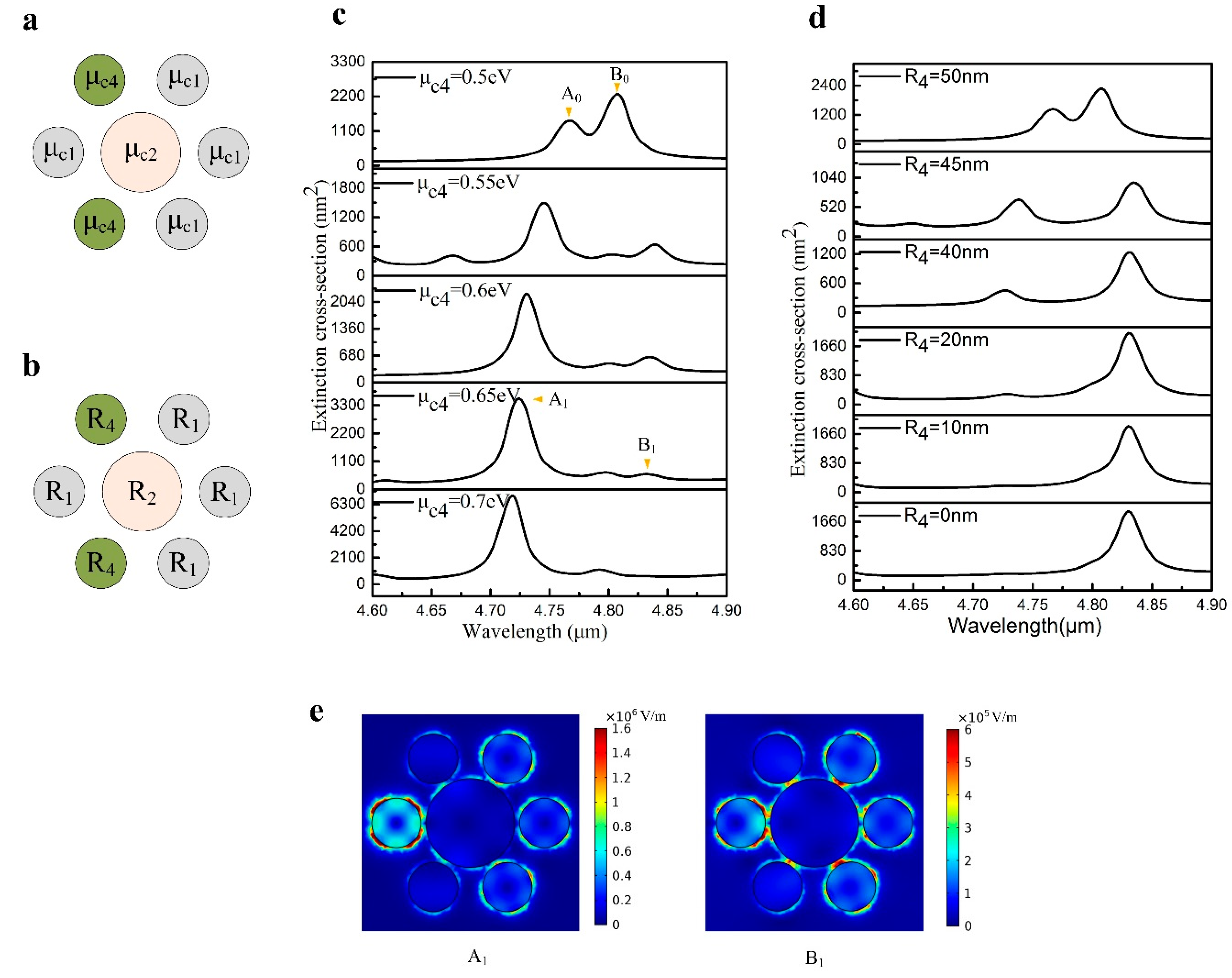
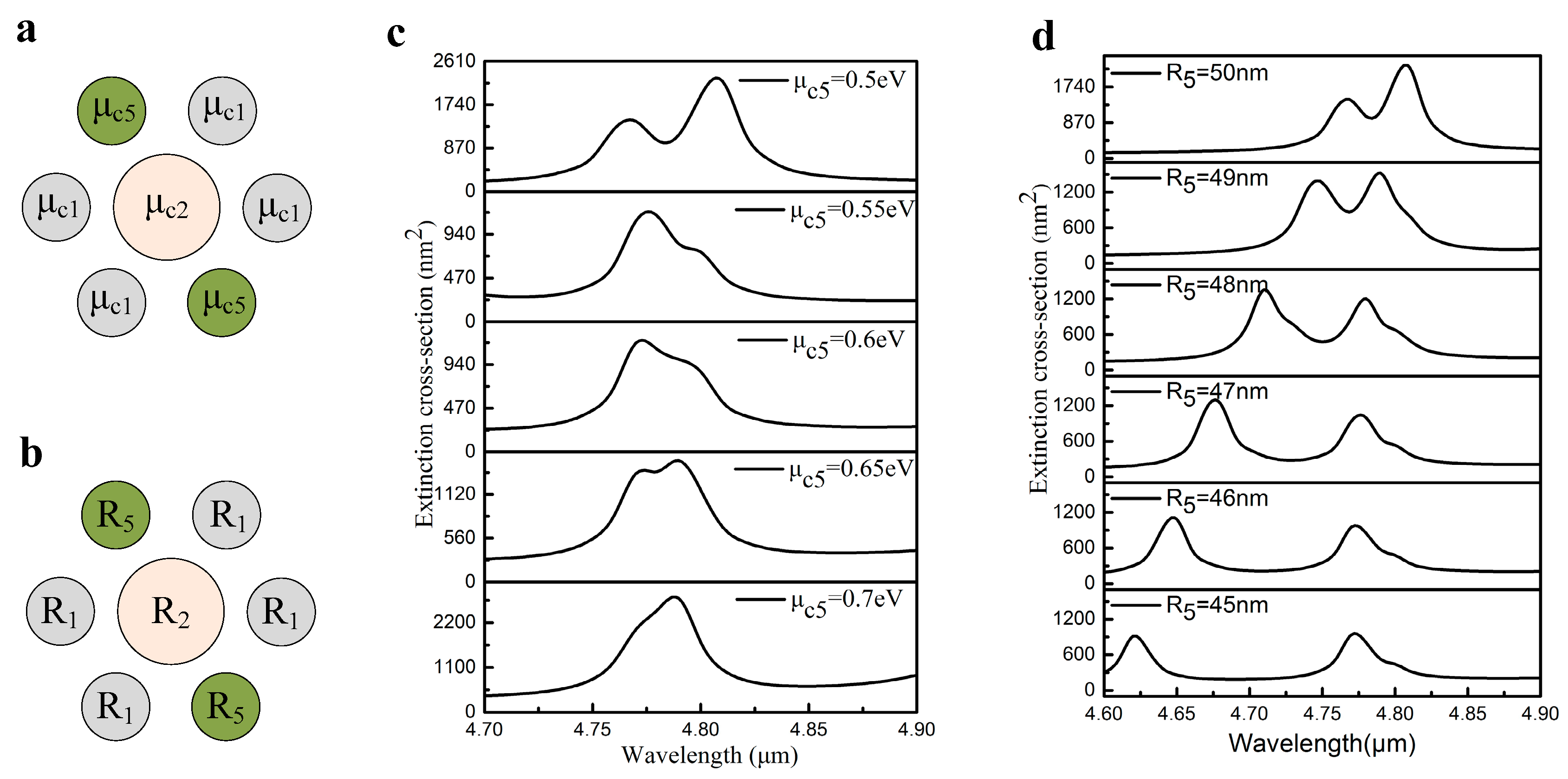
© 2019 by the authors. Licensee MDPI, Basel, Switzerland. This article is an open access article distributed under the terms and conditions of the Creative Commons Attribution (CC BY) license (http://creativecommons.org/licenses/by/4.0/).
Share and Cite
Zhou, H.; Qiu, W.; Wang, Z.; Ren, J.; Zhao, Z.; Lin, Z.; Qiu, P.; Kan, Q. Effect of Nanodisks at Different Positions on the Fano Resonance of Graphene Heptamers. Appl. Sci. 2019, 9, 4345. https://doi.org/10.3390/app9204345
Zhou H, Qiu W, Wang Z, Ren J, Zhao Z, Lin Z, Qiu P, Kan Q. Effect of Nanodisks at Different Positions on the Fano Resonance of Graphene Heptamers. Applied Sciences. 2019; 9(20):4345. https://doi.org/10.3390/app9204345
Chicago/Turabian StyleZhou, Hengjie, Weibin Qiu, Zeyu Wang, Junbo Ren, Zeyang Zhao, Zhili Lin, Pingping Qiu, and Qiang Kan. 2019. "Effect of Nanodisks at Different Positions on the Fano Resonance of Graphene Heptamers" Applied Sciences 9, no. 20: 4345. https://doi.org/10.3390/app9204345




